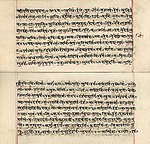Portal:Religion/Selected scripture/3
Hindu scripture, which is known as "Shastra" is predominantly written in Sanskrit. Indeed, much of the morphology and linguistic philosophy inherent in the learning of Sanskrit is inextricably linked to study of the Vedas and relevant Hindu texts. Hindu scripture is divided into two categories: Śruti – that which is heard (i.e. revelation) and Smriti – that which is remembered (i.e. tradition, not revelation). The Vedas constituting the former category are considered scripture by all Hindus. The post-Vedic Hindu scriptures form the latter category; the Mahabharata and the Ramayana are notable epics considered scripture by many sects. A sort of cross-over between the religious epics and Upanishads of the Vedas is the Bhagavad Gita, considered to be revealed scripture by almost all Hindus today. The Puranas are a vast literature of stories and allegory. Eighteen are considered to be Mahapuranas, or Great Puranas, and thus authoritative references on the Gods and Goddesses, religious rites and holy places (most of which are in the Indian subcontinent, known as Bharat).
Hindu texts are typically seen to revolve around many levels of reading, namely the gross or physical, the subtle, and the supramental. This allows for many levels of understanding as well, implying that the truth of the texts can only be realized with the spiritual advancement of the reader.

